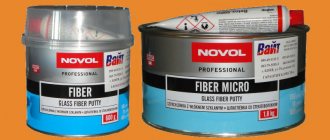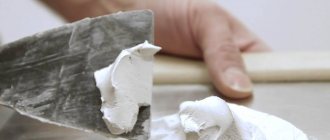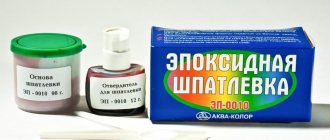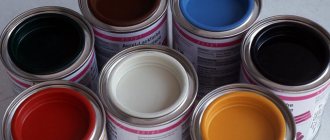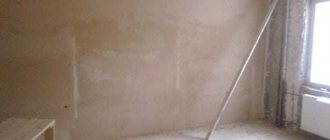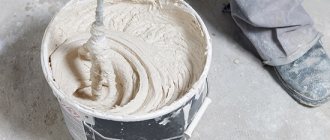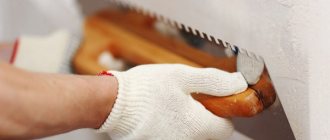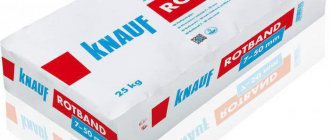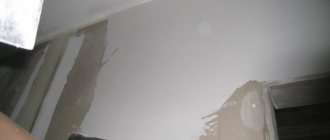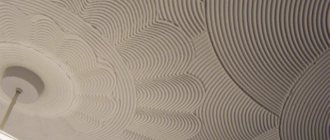Often, when it is necessary to carry out body repairs on a car, you have to use putty. These are special automotive putties that are used to work on metal or plastic, as the main materials for the manufacture of the car itself.
Car body puttying
Let's consider questions about what types of putty there are for cars and how to choose the appropriate composition.
What is putty? Compound. Purpose
Among car mechanics, putty is a product in the form of a paste, powder or liquid substance that is used to level the surface in preparation for painting.
The main purpose of automotive putty is to fill holes and chips, smooth joints or welds, and eliminate other minor defects in metal and plastic surfaces.
In addition, the use of the material during vehicle restoration work is the best way to prevent corrosion.
It is not recommended to use auto putty in the presence of deep damage over a large area.
Features of the composition
The car putty contains several functional fillers:
- polymer (polyester) - resin. This is the main binder that ensures adhesion, hardening, strength and elasticity of the coating;
- inert substances of various sizes - chalk, talc, gypsum;
- styrene is a partially evaporating solvent responsible for the rate of polymerization and shrinkage;
- fiberglass - has the property of reinforcement, is responsible for the strength of the connection of parts in case of through damage;
- aluminum powder - due to its resistance to temperature, it is used in areas of high heat;
- hollow glass beads - necessary to reduce the specific gravity of the product and facilitate its subsequent processing;
- pigment - responsible for the color of a substance.
Additional components of the product include a hardener for putty - a catalyst that is added to the main composition immediately before use.
According to experienced craftsmen, the performance properties of auto putty depend on the quality of the main component - polyester and the amount of solvent.
Fiberglass putty.
FIBER - putty with the addition of fiberglass fibers. Thanks to fiberglass, it has high mechanical strength, but has a rather average ability to fill irregularities and holes. Those. Micropores cannot be covered with this putty. This putty is intended for large surfaces, for initial application, to add rigidity. When applied, pores will remain in it, and it must be covered with a soft or universal putty.
Fiberglass putty can be used on the following types of surfaces:
- polyester putties,
- aluminum,
- steel,
- two-component acrylic primers,
- old varnish coatings.
The following can be applied to putty with fiberglass: universal putty, finishing polyester putty, polyester putty applied by spraying, acrylic primers.
Universal putty.
Basic universal putty. Moderately hard and with little elasticity, recommended for fur. processing, for use on small surfaces. It has very good adhesion to various types of substrates, but is not recommended for use on galvanized steel.
Can be used on the following types of surfaces:
- polyester laminates,
- steel,
- aluminum,
- two-component acrylic primers,
- old varnish coatings.
The following can be applied to the universal putty: Polyester finishing putty, polyester putty applied by spraying, acrylic primers.
Attention - if you fill a large surface (hood or roof) with universal putty, with a high degree of probability, after a few months, due to mechanical bending or temperature changes, the putty will crack!
If you need to putty the surface, use putty with aluminum filler.
Finishing putty.
FINISH - finishing putty for application with a spatula. Serves for repairing small surfaces and final finishing leveling of the surface before applying primers. Thanks to the fine fillers, it is ideally applied in thin layers and fills small depressions and scratches. But in practice, this putty is completely useless, since the defects that it removes can be filled with liquid putty, which is faster and more effective.
Liquid putty.
Finishing finishing liquid putty, applied by spraying. Allows you to obtain a smooth surface even over large areas. The polymerization time is about 2 hours, but it can be reduced by increasing the temperature to 60°C. The putty is suitable for mechanical and manual processing with sandpaper.
Liquid putty is used to mask the contours of the putty, as well as to remove pores and scratches. Several layers of liquid putty can be applied on top of the finishing putty, extending to the border of the repaired area. Liquid putty will provide a reserve of thickness for subsequent sanding of the area. Sanded with P220-P240 abrasive before applying secondary primer.
Liquid (Spray)
The use of liquid putty for car repairs is appropriate when treating damage of any size and depth. Typically the material is used for finishing large surfaces.
To evenly apply liquid car putty, use a special gun. The liquid from the bottle is filled into the container with which the instrument is equipped and the composition is applied to the surface using a multi-layer spray method.
The material has a long hardening time - up to two hours. After drying, the coating needs to be sanded.
Every master who repairs a car with his own hands always has several types of putty materials in stock. The minimum set of necessary compositions for repairs includes filler, finishing and plastic putty.
Manufacturers
On the market you can buy putty for your car from the following manufacturers:
- Carfit . This two-component composition is used on passenger cars and other types of cars. Creates a non-porous surface when drying quickly. Apply a layer of up to 35 microns. Cannot be applied over epoxy primer. Mixes with hardener in a ratio of 3.5:100 and dries up to 5 hours;
Liquid putty CARFit Spray
- A80 with Roberlo activator . It has a good ability to fill microcracks and finish the body to a perfectly smooth state. It is characterized by the absence of spreading and is often used when applied to welding seams. This material must be processed with a filler that is appropriate in technology;
A-80 Liquid putty with catalyst Roberlo, 1 l
- 791R . A two-component composition based on peroxide resins is intended for finishing the surface. A peroxide hardener is included in the kit. It grinds well and is applied to steel, creating a film with a high thickness and a uniform structure. It is not recommended to use putty on the surface of a car where a one-component or etching primer has been applied. It is also not recommended to apply thermoplastic paints or primers on top of such a base;
Spray putty (liquid) DuPont 799R + 791R
- Novol . It is applied using a spray gun to fill all sorts of imperfections in the car. Serves as an excellent insulator for metal, preventing moisture penetration. Diluted with 6 or 7% hardener. Applicable to metal and plastic and easy to sand;
NOVOL Spray putty (liquid) 1.2 kg + hardener
- Sprint . This liquid putty for metal based on polyesters quickly undergoes the polymerization process even when applied in thick layers. Helps fill large and microscopic pores, leveling hard-to-reach car surfaces. Another advantage of the mixture is thixotropy (no spreading when applied to vertical surfaces). High elasticity allows for easy sanding. It is recommended to use this mixture when filling a large surface;
Liquid putty Sprint 2K HS Spray
- Chamaleon . It has good filler properties, elasticity, and less weight compared to conventional putty. Dries up to 5 hours naturally and up to 1 hour at 60 degrees.
CHAMALEON 407 liquid putty for cars
One-component acrylic putty
Acrylic one-component finishing putty. It can be coated with any acrylic and base varnishes, so its main purpose is to fill very small scratches and surface irregularities immediately before varnishing, so it should be applied only in thin layers and treated with the same paper as acrylic primers.
Putty with aluminum filler (dust)
ALU - aluminum filling putty
with the addition of aluminum powder, which increases its resistance to elevated temperatures and guarantees excellent adhesion, which allows its properties to be compared with PROFICYNK putty. It has less shrinkage compared to typical putties, as well as high elasticity, thanks to which it is used for leveling large-area unevenness.
Can be used on the following types of surfaces:
- polyester laminates,
- steel,
- Cink Steel,
- aluminum,
- two-component acrylic primers,
- old varnish coatings.
Preparing your car for painting with your own hands
Compliance with the correct surface treatment technology before starting work is the main condition for obtaining a reliable and high-quality coating, a long-lasting effect of cosmetic repairs, and the accuracy of recreating the original lines and contours.
Before starting the puttying process, it is necessary to perform several preparatory operations on the surface of the car. Namely:
- grinding the treated area;
- elimination of dust deposits;
- degreasing metal or plastic;
- surface treatment with anti-corrosion primer.
Special paper is used for sanding metal and plastic elements. Large surfaces can be machined, while small damaged areas can be carefully sanded by hand. Emery cloth has different gradations depending on the grain size.
How to properly apply and process the material with your own hands?
Before starting work, the putty is thoroughly mixed with the hardener until the mixture becomes homogeneous and the pink streaks completely disappear.
Important! It is necessary to observe the required proportions of the mass of the base and hardener, otherwise the repair composition may crack and it will be necessary to carry out the repair again.
To apply the putty mixture you need a set of special spatulas of various shapes. To achieve a smooth surface, you need to practice techniques for quickly and accurately applying alternate layers.
If a deep dent on a bumper or threshold is being filled, it is a mistake to try to close it completely in one step by putting a lot of putty on the working part of the spatula. The best option is to apply 2-3 layers of coarse or universal putty. This will save both time and material. Since while the putty dries for 15-20 minutes, you can work on two damaged areas in parallel. It is recommended to putty in a warm room with subsequent drying of the repair area, since at sub-zero temperatures the putty does not gain all its strength properties and does not dry.
Detachment can also occur due to a violation of the temperature regime. Typically, manufacturers recommend working with this material at a temperature not lower than +50°C.
When the putty has “set”, you can begin sanding the surface using a block or a special plane.
It is advisable to conduct a development express test .
To do this, spray black paint from a can on the surface in small dots or use developing powder. After sanding, areas that require additional application of compound will be visible. If the dent has almost completely leveled out in appearance, finishing putty is applied to the surface. After it dries, take abrasive sandpaper P240 , which needs to be used to treat not only the dent itself, but also the adjacent areas. A fine-grained abrasive will help form a smooth transition that hides the location of the former defect. And the final stages of processing are degreasing and priming.
Since each spatula has its own contour, the formation of protruding strips of putty on the surface is inevitable. This is the main difficulty of the process. While the material is soft, it is difficult to eliminate stripes: this will only create unnecessary depressions. After drying, it is also difficult to clean off excess relief; it will require a lot of time and effort.
The hardener added to the mass first hardens, then crystallizes, and approximately 5 minutes after application the material acquires an elastic rubber-like structure. At this point, the protruding stripes can be easily cut off with a sharp blade or knife.
Interesting! In order not to miss this short moment, you need to test the surface with your fingers. Due to the chemical reaction, it will become hot, this will be a signal that it is time to take a knife and carefully cut off the excess.
Proportional ratio of putty and hardener - how to dilute and use
Any automotive putty mixture, no matter what it is, comes complete with a small tube of the substance. Here's how long it takes for car putty to dry. It is a material hardener, also called a catalyst or activator. Terminology directly depends on the manufacturer.
The main thing is to use this substance, diluting it with the putty itself, since without it the material will not acquire its properties. The main problem with this process is the question of how to properly dilute automotive putty.
Mostly one tube of hardener is designed for the entire can of putty. But it is not always worth using such an amount of material. First of all, this applies to cases where the car only has a small dent or a bent threshold.
Leaving the prepared putty mixture, which could not be used, for later will not work. This is due to the fact that this material, when mixing the components, immediately begins to set and harden.
If you need to use only a small amount of putty, it is best to take as a basis a proportional ratio of 100: 1. Here we talk about how long it dries. The vast majority of manufacturers use it. But in some cases, the instructions may indicate an even smaller amount, proportional to 200: 1.
That is why, before starting work, it is worth carefully examining the container in which the putty was sold. It is necessary to take into account not only the instructions, but also the ambient temperature. Professional craftsmen know about this nuance and always rely on it when repairing vehicles.
Most often, at a temperature of 20 degrees Celsius, it requires about 2 grams of hardener per 1 kilogram of putty mass. If the temperature increases by at least 10 degrees, then it is worth adding an additional 1 gram of catalyst. First of all, this applies to formulations that do not contain fillers.
Before you properly dilute car putty, you should definitely read the instructions for using the material.
It may indicate some nuances that are unique to this product from a particular manufacturer.
Finishing layer of automotive putty
The finishing coat is applied to the entire repair area. This is a thin layer of putty. You can add some polymer from a fiberglass repair kit to the putty. Approximately the same amount is added as the hardener from the tube. Next, add putty hardener and stir. The resulting putty is easily applied in a thin layer and is well leveled. When curing, a slightly sticky layer may form on top of the putty surface. You can remove it with a solvent and start sanding.
How to divorce?
Automotive putties are sold in two-component form: putty mass (or base) and hardener. The base is a plastic substance that has good adhesion and pliability under external mechanical influence. The hardener is used to convert liquid putty into a solid mass.
The vast majority of modern putties are diluted according to the same scheme: 2-4 grams of hardener per 100 grams of putty. In this case, the choice of the exact proportion depends on weather conditions and requirements for hardening speed. In dry, hot weather, 2 grams is enough. If the weather is humid and cool, or accelerated curing is required, the proportion can be increased to 4-5 grams per 0.1 kg portion of base.
Mix the base with the hardener slowly, with soft plastic movements and always by hand. Do not beat car putty using mechanized means. This can saturate it with air, which will weaken the frozen layer on the workpiece.
If, after adding the hardener and mixing, the putty has acquired a noticeable reddish tint, you should not use it. It's better to prepare a new portion. Excess hardener may cause a red tint to appear through the paint.
How to dilute correctly, in what proportion to stir and cook
You can prepare the putty mixture either on a small piece of organic glass or on a special tool. But, despite this, many craftsmen prefer to use only two spatulas of different sizes. They should be cleaned immediately after work, before the remaining material has completely hardened.
If this happens, it will be quite difficult to remove them later. And this is important so that even the smallest irregularities are not left on the tools, as this may affect the quality of further work with their help. Additionally, they can be cleaned using a special solvent.
Storing putty involves settling of solid particles from its composition and the formation of a film of resin on the surface. As a result, before using this material, it is worth stirring it very thoroughly, thereby obtaining a homogeneous mass with which you can further work.
In addition, in this case, the correct mixing ratio can be achieved, since the filler will not participate in the reaction. To remove the putty from the container in which it is located, you need to use only clean tools.
Residues on them may react adversely with the material. This can affect its quality.
The putty should be applied to the surface using a spatula. They can be made from thin steel or ordinary stainless steel.
Application
There are also products made of rubber or plastic. They can also be quite convenient in some cases. If you need to finish fairly large surfaces, you can also use a construction spatula for finishing work. In this place about a spatula for puttying walls. A ruler can also be useful to control the shape of the sanded surface.
Polyester putty is a material consisting of two components. They must be mixed immediately before work.
In this case, the resin with a hardener, which acts as a catalyst, can properly level the surface.
Polyester
In this case, you should definitely follow the proportions established by the product manufacturers. The putty should only be applied in a thin layer. A layer that is too rough will not allow you to obtain a high-quality coating.
After preparation, you need to work with the putty in a fairly quick time - from 5 to 10 minutes. That is why the layer should be applied in a short time and very precisely.
It is because of this that there is no need to mix components in larger quantities than required.
It is worth highlighting two features of this process:
- If too little hardener is used, the material will not cool in the required time. As a result, sanding will be quite difficult, since the putty will clump into clumps, resulting in scratches and unevenness. Here about mechanized;
- if there is a small amount of hardener, the material will not cool quickly. It will contain an active catalyst that will react with the resin and pigments. Subsequently, uneven coloring will appear on the surface, spots will appear, and the contours of the painted areas will become noticeable.
It is in connection with the above-mentioned features of diluting putty that it is necessary to adhere to the instructions for use and the manufacturer’s recommendations.
For more information on how to properly dilute putty, watch the video:
How to apply car putty correctly?
There are simply no universal answers to the question of how to putty correctly. Each master works in his own style. However, there are a few general recommendations that most bodybuilders adhere to.
- Work out in advance the question of which putty is best to eliminate the defect in your specific case.
- You need to prepare as much putty at a time as is required to treat one element or one defect. The hardener will turn the putty into a wax-like mass unsuitable for application in 5-7 minutes.
- Choose a spatula that is suitable for a particular case. There is no point in using a large wide spatula to stretch an area 3 times smaller than the spatula itself. The same applies to large areas of treatment: you should not try to pull them out with small spatulas.
- There is no need to try to immediately bring the surface to the ideal using only spatulas. The main thing is to fill the defective area well and carefully. And micro-irregularities and “snot” will be removed with sandpaper.
Experienced body workers work slowly, but without breaks within the framework of one defect.
Sanding and finishing putty
Surface grinding can be done either manually or using an eccentric sander. For manual grinding, sanding pads (grinding pads) are used. There are various shapes, sizes and compositions, plastic, rubber, foam and others. Sanding CANNOT be done while wet! This is done due to its high hygroscopicity (ability to absorb water). When wet sanding, the putty picks up water, which reaches the metal and leads to corrosion. Water can also lift subsequent coatings. After curing, about 20-30 minutes, you can start sanding. First, it is recommended to remove the top sticky layer with a grinding machine so that the abrasive does not become clogged during manual processing. Start grinding the putty with an abrasive no rougher than P60-P80; the final sanding of the area for subsequent application of secondary primer is carried out with a P220-P240 abrasive. All layers of putty must be applied to a surface that does not have deep scratches from coarse abrasives. Putty placed over rough scratches may sag and the scratches will be sealed. Important point “Rule of increasing gradation”.
After rough sanding, the surface will have deep scratches. To be sure to remove them, you will need an abrasive whose grain size differs from the grain size of the previous abrasive by no more than 100. For example, you pre-sanded with P60 abrasive. To remove rough scratches, you choose the nearest P150 abrasive. If you take, for example, P220, then it will not be able to remove scratches from abrasive with P80 grit. Boundary zones should be sanded with fine sandpaper or matted with Scotch Brite. An area approximately 15 cm wide should be matted around the putty surface. Here are a few more tips to follow when puttingtying a car with your own hands:
- You should always degrease the cleaned surface thoroughly before each layer of putty.
- Before use, mix the putty well; over time, it will settle in the jar.
- Add hardener in a certain ratio to the putty (as indicated by the manufacturer)
- Do not mix a large amount of putty at once, since when adding a hardener you have 7-10 minutes before it begins to harden, you simply will not have time to distribute it on the surface of the part. It is better to calculate the amount of work in advance and dilute the required amount.
- Don't try to display the form all at once. Divide into several approaches.
- For quality control, use “Developer Powder” or development in the form of aerosol black paint.
- If you are going to putty on metal where there were pockets of corrosion, then you need to apply “Acid Primer” to this area, then “Soil Filler”, then you can apply putty or epoxy primer, then putty. You can be sure that after such treatment, the repair will be of much higher quality and the part will last much longer.
- “Control for glare” - Apply degreaser to the part from the dispenser and you will see irregularities in the glare.
What does putty consist of, types
There are several types of putties on the modern market. Each of them meets a number of criteria and is used in individual cases.
Firstly , it must have high-quality connecting characteristics with a properly processed area.
Secondly , the solution must be spread evenly on the surface of the machine.
Thirdly , the putty must have excellent shrinkage, and this is possible with high-quality material.
In this procedure, not only the material is important, but also the high-quality processing of the body. The mixture you choose must be compatible with the future paintwork.
There are these types of putties:
- Rough putties are applied only if serious defects form on the body - sweeps, cracks. Such material often contains some kind of filler, for example, shavings.
- This material has a number of features - easy grinding, can withstand high temperatures, and is very elastic, which allows you to level large surfaces.
- Fiberglass putties are very durable. When applied, the solution transforms into a layer of hard fiberglass, which is easily sanded. This material is ideal for covering holes caused by corrosion.
- Thin putties are used to repair minor damage, such as scratches. The final stage of puttying is carried out with this material. These include fine and nitro putties, which are then easily processed.
- Liquid materials are applied with a device - a gun, but this results in the most even layer possible. It only takes a few hours for it to dry.
- Universal putty is a replacement for the above options; you definitely can’t go wrong with it. At the same time, it is durable, has a uniform structure and is easy to process.
Owners of old cars often use thermoplastic acrylic varnish; it is not compatible with all putties; for this you need to read the instructions.
Some manufacturers are trying to produce paints and putties that are compatible with each other. Be sure to take into account the instructions, try to find out these acts in advance, which will save time and money.
The putty also varies depending on the type of base:
Nitrocellulose putties , where most are dry substances, are therefore used to eliminate minor defects. Such a base can dry in a few hours at room temperature. Since the composition contains solvents, they are toxic. Polyester putties are the best option for eliminating defects in the car body. They are easily leveled and can dry within an hour only at room temperature.
Acrylic putties are created taking into account the latest technologies, therefore they are environmentally friendly. There are no solvents in the content, the material dries instantly. Used to eliminate deep pores.
It is important to use and combine mixtures correctly. For example, if you combine them with a hardener, the coating will be damaged and work will have to start from the very beginning.
Therefore, it is difficult to say exactly which putty is best suited; all circumstances must be taken into account. How the putty dries directly depends on its composition.
For example, if you add a hardener to a two-component putty, it will dry faster - in half an hour, and the work will have to be done faster.
Epoxy putties will dry within 24 hours at room temperature.
To reduce drying time, many people use hot drying. But this procedure must be carried out carefully, maintaining the putty coating at room temperature.
To carry out all the work, you must stock up on a mask, goggles, and special clothing. This material is safe, only dust that can get into the lungs during grinding is harmful, so it’s worth considering protective equipment.
Putty rules
To get a high-quality, smooth surface after puttying, you need to follow some rules:
- Degrease and clean the damaged area;
- Combine putty and hardener in the correct proportions, depending on the expected effect.
Important! It is not necessary to use a lot of hardener; too much will lead to cracks.
- Clean the spatula before applying putty for your car;
- If there is a large volume of work, it is better to apply several thin layers rather than one thick layer in order to avoid the entry of air and increase the density of the composition;
- There is no need to sand the product if the next layer is leveled in the interval from ¼ hour to 1;
- It is better to use a medium-sized spatula when applying, and level with a large one.
Applying automotive putty to the ground
It is recommended to apply the putty only on primer with an admixture of epoxy. This is carried out during restoration, and not during full repair of damage, when the car is cleaned to bare metal in order to protect the surface from corrosion. When quickly restoring a car's surface, the use of primer is not required.
Finishing coat of automotive putty
This putty is applied in a small thickness and is well evenly distributed over the surface. When the coating begins to harden, a sticky feeling is possible, which can be removed with a solvent, and then the damaged area is sanded.
What sandpaper should I use to sand car putty?
After drying, the first layer of automotive putty is traditionally sanded with P80 sandpaper. This is a fairly coarse-grained sandpaper, but it can be used to roughen the bottom layer conveniently and quickly.
Further, the grain increases by an average of 100 units with each subsequent processing. This is the so-called “rule of one hundred”. That is, after the first rough grouting, paper with a grain size of P180 or P200 is taken. Then we increase it to P300-400. We can stop here. But if a perfectly smooth surface is required, then it would not be superfluous to use finer-grained sandpaper.
After sanding, it is recommended to rinse the treated surface with water.
Recommendations
- Mix the putty and hardener thoroughly. A hardener that does not react with the putty will subsequently appear through the layers of the coating in the form of spots.
- In hot weather, the amount of hardener that needs to be added to the putty is approximately halved.
- In order to dilute the thick putty, you can add a little polymer from the fiberglass repair kit to it.
- The jar of putty must be tightly closed during storage to prevent the putty from drying out, otherwise it will lose its elasticity.
- The roof, hood, and doors are body elements that are affected by increased vibration. On these elements you need to use elastic putty to avoid cracks. Putty with aluminum powder and putty with carbon fiber are suitable.
Features of the use of various types of putties
Different types of putties differ in properties and this must be taken into account when using them. When using putty masses, it is necessary to take into account their specifics:
- Fiberglass compounds are difficult to sand when dry, so half an hour after application they are covered with a more pliable type of material.
- aluminum compositions remain soft 4 minutes longer than other types of materials, but require special care when kneading, since aluminum particles are prone to settling. Otherwise, a resin that is unable to harden will remain on the surface of the composition;
- finishing materials cannot be applied in a layer whose thickness is more than 1.5 mm. The total thickness of the putty layer should not exceed 3 mm. And deep damage should first be repaired using filling compounds;
- Liquid products are applied in three layers, the total thickness of which does not exceed 4 mm. The recommended nozzle diameter for a spray gun is 2.5 mm.
The main characteristics of the materials and features of their use are indicated in the packaging instructions. It is important to follow these rules and avoid using solvents not specified in the technical description.
Tools and materials for puttying work
In order to putty a car at home, you will need the following set of materials and tools:
- means for removing residual dirt and stains;
- hardener;
- solvent;
- putty;
- putty knife;
- sandpaper;
- grinding wheel;
- protective gloves.
Drying the putty
In most cases, puttying slows down due to the slow hardening of the layers. The drying process of the mass depends on the ambient temperature - the warmer the air, the faster the polymerization of the material occurs.
Therefore, to speed up the process, car enthusiasts resort to artificial heating of parts using hair dryers and lamps.
At a natural air temperature of 20 °C, the sealing layer becomes ready for sanding in half an hour. Additional heat sources can reduce the drying time by several minutes, but can also change the performance properties of the putty.
Warming up parts is especially important at low temperatures. To do this, it is enough to evenly heat the surface to be treated from the inside and outside. Under no circumstances should the putty be overheated to prevent it from overdrying and cracking.
After the putty coating has completely dried, its surface is sanded with a fine-grained abrasive and a primer is applied to improve the adhesion of the paintwork.
The effectiveness of putty materials depends not only on the quality of the compositions, but also on strict adherence to the technology of their use. And if you don’t have enough experience, it’s enough to follow the proportions and rules of mixing, use the method of multi-layer application followed by sanding and not deviate from the recommendations indicated in the instructions.
On metal or on soil?
Many types of putty masses tend to absorb and retain moisture. Therefore, before applying them, it is necessary to prime the surface to protect the metal from possible moisture accumulation and corrosion. The recommended soil layer is 2.5 mm.
Epoxy primer has good adhesion to any type of putty and anti-corrosion properties. The epoxy resin product is suitable for all types of surfaces, including galvanized or aluminum.
When using fiberglass putty, it is permissible to apply the product directly to the metal or to the primer.
For plastic parts, a special one-component primer plasticizer is used.
What mistakes do beginners make?
To carry out the work correctly and achieve the desired result, you should strictly follow the instructions, choose the right material and listen to some recommendations.
Beginners often rush and manage to create problems that are then more difficult to fix than applying the coating.
It is important to remember and follow these recommendations:
- Carry out all work on a dry surface, because moisture forms corrosion, which corrodes the surface. During preparatory work, when you wash the car, let it dry thoroughly;
- You cannot put putty on a glossy surface; it will simply peel off. Degreasing, cleaning and only then applying a layer of putty.
- Two spatulas are used in the work - for applying large and small putty.
- Before each application, stir your mass, because thick components form at the bottom, and resin on top.
- draw up a work plan for yourself, describe at what stage and what materials will be used, then you will definitely not confuse anything.
- You should not add hardener to the jar of putty material; try to follow the proportion specified in the instructions;
- Many people mix more putty, and then are left without material, because they forget that the material hardens in 10 minutes. During this time it is impossible to process all areas, so separate the material.
- hold the spatula at a 60 degree angle.
- acid primer, primer-filler is used in areas with corrosion, which cannot simply be left without treatment.
- To avoid the appearance of pores when applying the material, the material should be thoroughly mixed.
Puttying a car is a very labor-intensive process, especially if you decide to do it yourself.
It is important to take this issue responsibly and carry out the work calmly and confidently; this is the only way to achieve a perfectly flat surface, onto which paint can then be applied.
Criterias of choice
The composition is selected taking into account the following circumstances:
The choice also depends on what surface you plan to repair. Purchase a paste with good adhesion to this material.
Pay attention to the following parameters of the repair composition:
Expensive compounds are easy to use and provide a durable, smooth coating.
Application of polyester
Understanding how to dilute putty for auto proportions is also worth knowing how to work with the created material. Without this, it is impossible to achieve the desired result.
Before you begin work on eliminating a flaw on the surface of a vehicle, it is necessary to degrease the surface, as well as grind it.
The thickness of the putty should not be allowed to exceed the limits of 450-500 microns. The thinner it is, the less work will be required later related to grinding.
It is believed that it is quite correct to apply polyester putty to bare metal or a previously prepared machine part. Galvanized products require the use of a universal material. You can also use putty with zinc on them. Here's about wood putty.
The material can be applied to primer with an epoxy resin base. Sanding bare metal can be done using P80 abrasive. If you need to repair old paintwork, then it is best to use abrasive from P180 to P240 as a final sanding.
This can significantly improve the quality of the connection between the putty and the damaged surface itself. Under no circumstances, according to the experts, should you apply the putty mixture to acidic soil. You should not try to eliminate all the irregularities in one approach.
Apply the material only with a clean spatula. The work should be completed at the moment when the putty is noticed “dropping” on the surface. After a certain period of time they will take on a solid appearance. For a good result, this procedure must be carried out several times, alternating it with grinding.
Benefits of use
Liquid putty is applied to the part using a spray gun and dried with ultraviolet light. The final stage is sanding. To do this, use fine-grain sandpaper. The use of liquid putty allows you to:
- hide even clearly visible dents, cracks and paint chips;
- filling microcracks and pores, preventing corrosion processes;
- protect against peeling of the paint layer applied on top, ensuring a long-lasting effect from the repair performed.
